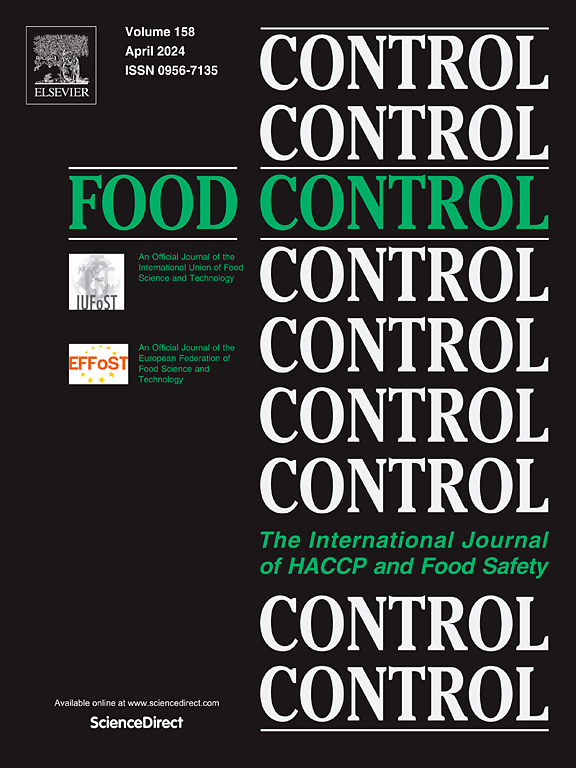N, S-CDs用于比色/荧光双模纳米传感器和智能手机测定水果中的姜黄素
IF 6.3
1区 农林科学
Q1 FOOD SCIENCE & TECHNOLOGY
引用次数: 0
摘要
以间苯二胺和β-巯基乙胺为前驱体制备了N, s掺杂碳点(N,S-CDs),并设计成比色/荧光双模纳米传感器。姜黄素(curcumin, CUR)可猝灭509 nm左右的绿色荧光。荧光猝灭的机理主要归因于静态猝灭效应。同时,当CUR含量在0 ~ 50 μM范围内变化时,测得传感液的颜色变化。因此,基于比色法和荧光法双模传感方法可以实现对CUR的定量测量。该双模传感器具有宽线性度和低检出限的特点。通过水果样品中CUR的测定,不断证实了该系统的可行性。此外,基于N, S-CDs的便携式智能手机辅助检测系统为实际水果样品中的CUR检测提供了一种简单、廉价、高效的方法。本文章由计算机程序翻译,如有差异,请以英文原文为准。
N, S-CDs for colorimetric/fluorometric dual-mode nanosensor and smartphone-based determination of curcumin in fruits
N,S-doped carbon dots (N,S-CDs) were fabricated by utilizing m-phenylenediamine and β-mercaptoethylamine as precursors and designed as colorimetric/fluorometric dual-mode nanosensors. The curcumin (CUR) could quench the green fluorescence around 509 nm. The mechanism of fluorescence quenching was mainly attributed to the static quenching effect. Meanwhile, the color alterations of sensing solution were acquired with CUR contents changing from 0 to 50 μM. Thereby, the quantitative measurement of CUR could be materialized based on colorimetric and fluorometric dual-mode sensing methods. The wide linearity and low detection limit (LOD) were achieved through this dual-mode nanosensor. The feasibility of this system was continuously confirmed via the assay of CUR in fruit samples. Moreover, a portable smartphone-assisted detection system based on N, S-CDs suggested a facile, inexpensive, and efficient approach for detecting CUR in actual fruit samples.
求助全文
通过发布文献求助,成功后即可免费获取论文全文。
去求助
来源期刊

Food Control
工程技术-食品科技
CiteScore
12.20
自引率
6.70%
发文量
758
审稿时长
33 days
期刊介绍:
Food Control is an international journal that provides essential information for those involved in food safety and process control.
Food Control covers the below areas that relate to food process control or to food safety of human foods:
• Microbial food safety and antimicrobial systems
• Mycotoxins
• Hazard analysis, HACCP and food safety objectives
• Risk assessment, including microbial and chemical hazards
• Quality assurance
• Good manufacturing practices
• Food process systems design and control
• Food Packaging technology and materials in contact with foods
• Rapid methods of analysis and detection, including sensor technology
• Codes of practice, legislation and international harmonization
• Consumer issues
• Education, training and research needs.
The scope of Food Control is comprehensive and includes original research papers, authoritative reviews, short communications, comment articles that report on new developments in food control, and position papers.
 求助内容:
求助内容: 应助结果提醒方式:
应助结果提醒方式:


